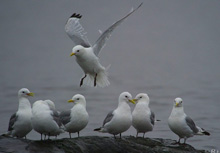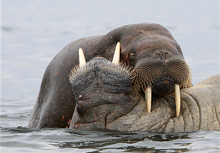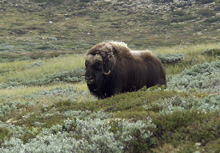Arctic Spitsbergen is absolutely rugged, with beautiful landscapes, the fjords, the glaciers, geothermal springs and the best place to see Arctic wildlife. Svalbard is home to seven national parks, twenty-three nature reserves cover two-thirds of the archipelago, protecting the largely untouched fragile environment. Extended daylight during summer make it a perfect setting to spot these arctic animals in the wild. Polar Bears, Narwhal, Walrus, Puffins and several other wild Arctic encounters await The Wildlifer!
Other attractions for the wildlifer apart from the wildlife are the Polar nights – when the entire archipelago is blacked out and there is no difference between day and night, the Northern lights or the Aurora Borealis – when the sky is filled with green, pink and purple and the Midnight Sun in August where the Archipelago is always lit with sunlight and there is no difference between day and night!
REACHING SPITSBERGEN
The most convenient way to reach Longyearben in Spitsbergen is via Oslo, Norway. There are several daily flights going to Oslo(2hours50mins). Svalbard Airport the closest airport( just 3 kms away from Longyearben) can be reached by several Norwegian and Scandinavian Air flights. It can also be reached via Tromso(1hour40mins).
One can get in and around snowladen Spitsbergen only via snowmobiles, boats and aircraft.
The Wildlifer’s hand picked cruises are however the best ways to discover Spitsbergen wildlife.
The Wildlifer’s choice of Safari
Choose your Safari experience specially handpicked for the wildlifer.
-
Nordvest Spitsbergen

Volcanic remains, glaciers, mountain peaks, warm springs are home to several birds and wildlife in this National Park. It also has several historical remains like the whaling stations and burial grounds from as far as 1600 A.D.
TOTAL AREA :
9,914 km²
WILDLIFE:
The Polar Bears, Walrus, Svalbard Reindeer, Arctic fox and several other species inhabitate the area. It is also an Important Bird area because of the presence of Barnacle, Brent Geese, Common Elders, Black Guillemots and several other seabirds.
-
Forlandet National Park

Known for its Stone Seals and world’s most northerly populations of Common Guillemot this park is a picturesque wetland of international importance. In the region there are numerous archeological remains from Norwegian and Russian hunters and whalers.
TOTAL AREA :
4,647 km² (616 km² land, 4,031 km² sea)
WILDLIFE:
This area is recognized for the world’s most northerly range of Stone Seals and also the world’s most northerly population of Common Guillemot. It has also been identified as an Important Bird Area (IBA) by BirdLife International because it supports breeding populations of Barnacle Geese, Common Eiders and Black Guillemots.
-
Indre Wijdefjorden National Park.

This park is known for its Great Fjord, the Wijdefjorden-the longest fjord on Svalbard that stretches from seaside to the glacial end of the island. On either side of the fjord rare Arctic steppe vegetation can be found — including plant species not known elsewhere in Europe.
TOTAL AREA :
1,127 km2 (435 sq mi), of which 745 km2 (288 sq mi) is land, 382 km2 (147 sq mi) is water.
WILDLIFE:
This area is very unique in its vegetation with some very exclusive plant species. It is the breeding ground for the Pink footed goose, the Svalbard ptarmigan. Polar bears, arctic foxes and the Svalbard reindeer can be seen in the park.
Itineraries – Here are some carefully selected itineraries for the Wildlifer

